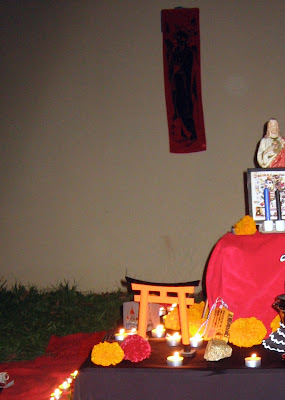Props to my husband for knowing about this film and suggesting we go see it. We actually saw
Visual Acoustics on its opening night at the Shattuck Cinemas in Berkeley. Subsequently, the film has also opened in San Francisco.

It was one of those nights where best laid plans went awry, and it was actually the second time within a month that my plans to have dinner at
Angeline's Kitchen and then see a movie at this theater have been thwarted. First there was Friday evening traffic on a rainy night, then the restaurant was teeming with patrons and there was too long a wait. So we went to
Beckett's Irish Pub instead, and by the time our appetizer and salad finally arrived, we had 3 minutes - literally - to chow down and get the check. It was not the relaxing night we wanted to have and tension was mounting. It took us more like 8 minutes to wrap up our pseudo-dinner of garlic fries and spinach salad.


We'd bought the movie tickets online, earlier in the day, and once again had to wait in line at the box office to pick them up. By the time we got into the theater, the movie had already begun and... drumroll please... there were no seats. I mean it, not a single seat in the house except for some large bean bags directly under the screen. What to do? There was actually a pool of people standing in the back because the theater had most definitely oversold tickets to the film. The manager said the only way we could have a refund was to leave. Instead, we sat on the floor, at the top of the center aisle and made the best of it. It'll be one of those experiences we look back on fondly, perhaps, in later years because it was something different. The time we sat on the floor.


We were, after all, on the hunt for inspiration. And we found it.

The film is about architectural photographer Julius Shulman, who made his career - and really pioneered the career of architectural photography - by taking pictures of the work of modernist architects. This includes the most notable Frank Lloyd Wright. The film follows modern day Shulman (recently deceased) as he returned to sites he'd once photographed, re-met architects he once worked for, and as he watched the Getty Museum pack up and move his entire life's work from his home to their archives - for posterity, but can you imagine?

The film reminded me of how interrelated things are: architecture, design, photography, engineering, etc. Many modernist architects were mindful of the landscape on which they were building and some of the more unique designs must have been feats of civil engineering. Shulman's photographs really did justice to the buildings and, as the film suggested, made a space look better than it was - which is maybe what most artists try to do: make life better, more beautiful, and more livable than it sometimes feels.

Sometimes the only time we notice design is when it's bad. For me, most often, I notice design in public restrooms, when stalls in an airport are too large or small, or when the paper is just out of reach. (And don't even get me started about modern tract homes!) Or this particular movie theater, as it were.
A lot of the modernist homes have a dated feeling - the boxy, clean lines, the simple materials - and don't always appeal to my aesthetic. At least, they didn't until I realized how much of the design was concerned with the way light would pass into the home and where it would fall. By contrast, many of the modernist public buildings are truly beautiful and often large and striking and strange. e.g. the Guggenheim.


Yesterday, the morning after the film screening, I met up for lunch with a girlfriend, her daughter and husband, and learned that her husband's job had something to do with looking for hazards - toxins, chemicals and other dangers - in things designed and built. New technology and new ways of doing things contain risk, and I guess it's his job to scientifically mitigate these risks; another unseen partner in those things designed and presented to the public to consume or inhabit. The things we don't think about by the time we stand in a space already constructed. It was Shulman's job to find the best way to look at these spaces, to put the viewer in the room with him. He was, essentially, selling the building, the architect, the principles. And he believed in the product because when post-modernism came along, he quit.
Shulman himself was inspiring. One thing I really liked was that he said that if there was something in the shot that he didn't like but couldn't change, then too bad. You have to work with what you have.
 Since I used up my leftover wrap last year, I was free this season to go hog wild, and I did. I bought everything I liked: prints in all colors, and glitter wrap in white and hot pink. It's uncharacteristic, but this year I am all about the shine. I even wore sequins to Thanksgiving.
Since I used up my leftover wrap last year, I was free this season to go hog wild, and I did. I bought everything I liked: prints in all colors, and glitter wrap in white and hot pink. It's uncharacteristic, but this year I am all about the shine. I even wore sequins to Thanksgiving.















































